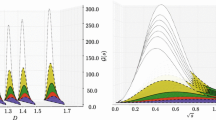Summary
We study a model for hadrons which identifies their internal degrees of freedom with « orbital excitations » and suggests a covariant formalism for their description. Assuming that the spin and the orbital degrees of freedom decouple in the Born approximation, we show how to construct wave functions, propagators and vertex functions for any meson-meson scattering process. We find that to preserve analyticity, crossing symmetry and Regge asymptotic behavior, the orbital states must transform according toreducible representations of the groupSL 2.0. The results are explicitly applied to \gp\gp scattering, where it is found that the amplitude constructed along these lines has a satisfactory low-energy behavior as well.
Riassunto
Si studia per gli adroni un modello the identifica i loro gradi di libertà interni con le « eccitazioni orbitali » e suggerisce un formalismo covariante per descriverle. Supponendo che lo spin e i gradi di libert\`a orbitali si disaccoppino nell\rsapprossimazione di Born, si mostra come si costruiscono le funzioni d\rsonda, i propagatori e le funzioni di vertice per ogni processo di scattering mesone-mesone. Si trova che, per la conservazione dell\rsanaliticit\`a, della simmetria incrociata e del comportamento asintotico di Regge, gli stati orbitali devono trasformarsi secondo le rappresentazioniriducibili del gruppoSL 2.0. Si applieano esplicitamente i risultati allo scattering \gp\gp. Si trova che l\rsampiezza costruita secondo i criteri esposti ha anche alle basso energie un comportamento abbastanza soddisfacente.
Резюме
Мы исследуем модель для адронов, которая отождествляет из внутрен-ниэ степени свободы с ≪ орбитальными возбуждениями ≫, и предлагаем ковариантный ф⊸рмализм для их описания. Предлолагая, что спин и орбит апьиые степени свободы развязываются в борновском приближении, мы показываем, как сконструировать валновые функции, пропагаторы и вершqiнные функции для любого процесса рас-сеяния мезона мезоном. Мы находим, что, для толо чтобы сохранить аналитичность, кроссинг-симметрию и асимптотическое поведение Педже, орбитальные состояния должны преобразовываться согласноирцво∂цмым предс талениям группыSL2,c. Эти результаты явио применяются к πп-рассению, где получется, что амчlитуда, сконструированная в этом направлении, также имеет удовлетворительое поведение при низких энергиях.
Similar content being viewed by others
References
T. D. Newton andE. P. Wigner:Rev. Mod. Phys.,21, 400 (1949).
G. Domokos, S. Kovesi-Domokos andF. Mansouri:Phys. Rev. D,1, 500 (1970), hereafter referred to as I;Phys. Rev. D,l, 512 (1970), hereafter referred to as II.
F. Mansouri: Doctoral Dissertation, The Johns Hopkins University (1969); unpublished, hereafter reierre4 to as III.
J. W. Moffat:Nuovo Cimento,64 A, 485 (1969).
G. Domokos andL. G. Tindle:Phys. Rev.,165, 1906 (1968).
M. A. Naimark:Linear Representations of the Lorentz Group (New York, 1964).
S. L. Adler:Phys. Rev.,137, B 1022 (1965).
Similar but not identical trajectories have been used byJ. W. Moffat: University of Toronto preprint, Feb. 1970.
C. Lovelace:Phys. Lett.,28 B, 265 (1968).
S. Weinberg.Phys. Rev. Lett.,17, 616 (1966).
Author information
Authors and Affiliations
Additional information
Research supported in part by U.S. Atomic Energy Commission under Contract No. AT(30-1)-4076.
Traduzione a cura della Redazione.
Rights and permissions
About this article
Cite this article
Mansouri, F. An orbital-excitation model for hadrons. Nuov Cim A 3, 220–238 (1971). https://doi.org/10.1007/BF02912618
Received:
Published:
Issue Date:
DOI: https://doi.org/10.1007/BF02912618



